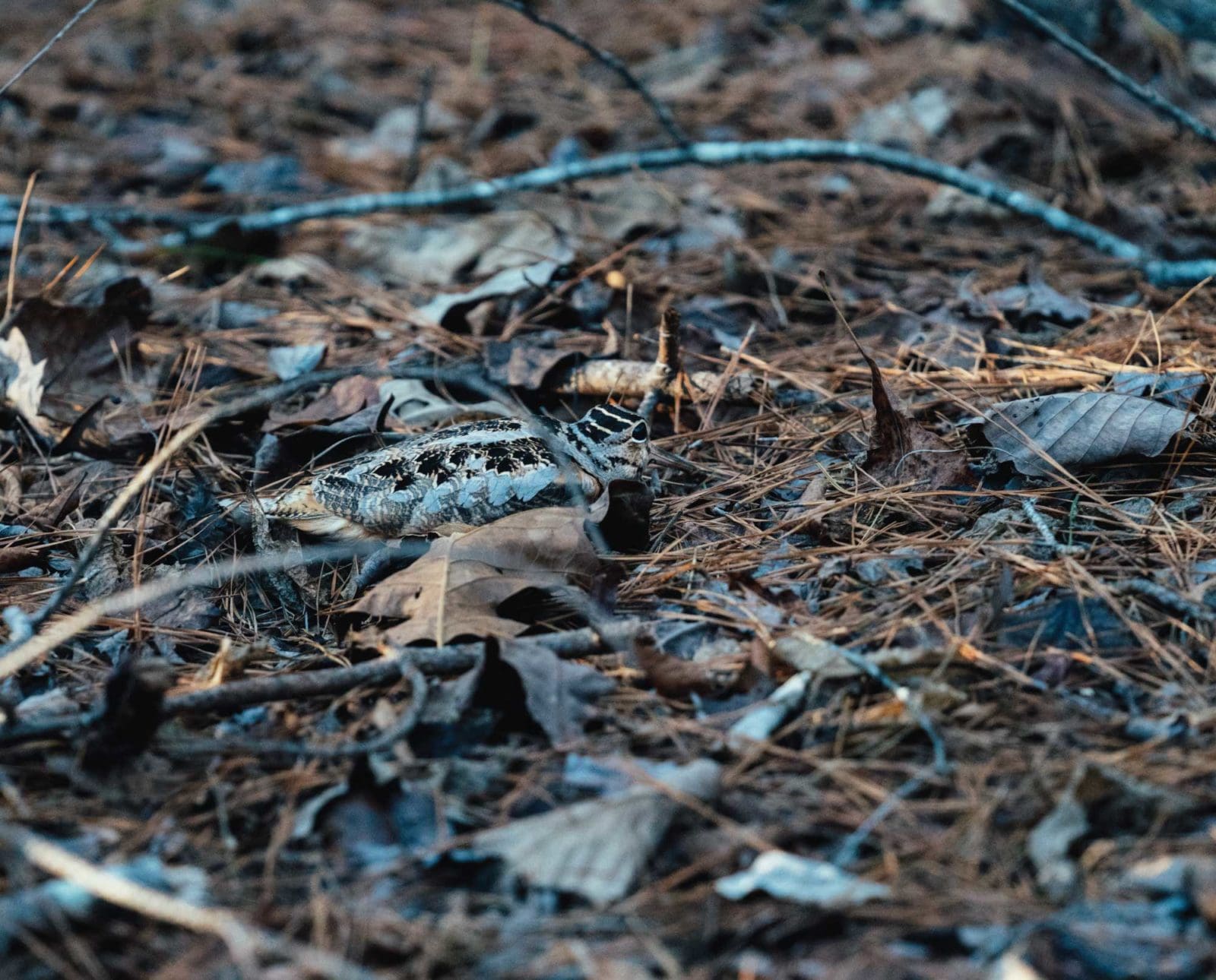Home » Woodcock Hunting » Unusual Facts About American Woodcock
Unusual Facts About American Woodcock

Gabby Zaldumbide is Project Upland's Editor in Chief. Gabby was…
American woodcock are, surprisingly, a migratory bird species with a strong upland hunting culture and history.
Natural selection has a funny way of influencing nature. American woodcock (Scolopax minor) are a fantastic example of this. Often referred to as Timberdoodles, the woodcock is one of those strange creatures bopping around our world as a result of evolution.
Listen to more articles on Apple | Google | Spotify | Audible
I can recall my first experience observing American woodcock. I was an undergrad studying wildlife ecology at the University of Wisconsin-Madison enrolled in a field ornithology course. My class took a morning birding trip out to the local arboretum and it just so happened to coincide with the woodcock’s breeding season.
One of the teaching assistants leading the field trip identified that classic peent call. We all raised our binoculars to try and catch the male in flight, performing an elaborate breeding display full of spirals, twittering, and zig zags. Then, we heard another one. Then, another one! The sky above the small forest was showered with breeding displays.
A small, plump bird, the American woodcock moves rhythmically through the forest whether they’re feeding or breeding. Their black and brown striated feathers serve as excellent camouflage and their long, malleable beaks probe the soil for earthworms. This is where natural selection comes in; because their preferred food lives underground, nature has selected for birds with upward-facing eyes that can scan the air for predatory birds while their bill pokes around for worms just under the earth’s surface.
If that information wasn’t weird enough for you, keep reading to learn even more quirky facts about the American woodcock.
Woodcock Are Technically A Shorebird
Taxonomy is the fancy term for the classification of species. American woodcock have been scientifically organized alongside related bird species. Because woodcock are found in the order Charadriiformes, family Scolopacidae, and genus Scolopax, that means they’re a shorebird, technically speaking. Although this species and its closest American relative, the Wilson’s snipe, are found in forests, its cousins are found in brackish marshes near salty waters. This includes species like Marbled Godwits, Sanderlings, and Semipalmated Sandpipers.
Although North America only has one native woodcock species, other species are found in Europe and Asia. For example, the Eurasian woodcock is found all across Europe from the southern tip of Spain, to Iceland, and its range even stretches over to Turkey. Strings of quality habitat can also be found in Nepal, eastern China, and Mongolia, too. Its coloring is rather similar to its American relative, however there is extensive barring along the Eurasian’s chest.
American Woodcock Like To Dance
Woodcock sometimes step gently on the surface of soil while rocking back and forth. You may have seen the viral YouTube video of this phenomenon with the song “Tequila” playing in the background. Woodcock begin to do this at just three or four days old. Humans don’t completely understand why woodcock exhibit this behavior, but scientific research proposes two prevailing theories.
One theory is that they’re feeling for earthworms and other invertebrates under the ground. However, a 2016 research article questions this idea’s validity. Instead, Dr. Berdt Heinrich proposes that woodcock rock back and forth when they know they’re being watched. He believes that much like the white-tailed deer that flares its tail when evading predation, woodcock do their rocking dance when they detect a mild threat in non-forested places like meadows or roads.
“The rocking walk display is likely to occur during foraging, because foraging is centered at a food-rich place that the bird may be reluctant to leave,” writes Heinrich. “The Woodcock’s rocking-walk display may act as a signal in a situation of a perceived potential audience or a predator, indicating that it is aware and can explode off the ground and escape if the predator seems likely to attack. The display saves the bird the energy and bother of flying off and possibly being chased.” His theory’s evidence is purely anecdotal, though.
This bouncy walk isn’t the only dancing this bird does; they also have a prolific “sky dance” during the migration season. Aldo Leopold wrote on the American woodcock, mentioning that their breeding dances were “a refutation of the theory that the utility of a game bird is to serve as a target, or to pose gracefully on a slice of toast.”
Male woodcock put on these evening display flights to attract females. Each male will take to the sky while making their buzzy peent calls. Then, he’ll fly in an upward spiral until he reaches 200 to 350 feet high. As he climbs higher, he twitters his wings more and more. Lastly, he pivots and begins to zig-zag back down to the ground, landing silently and ideally near a female woodcock. These flights even continue after females have laid eggs. There are some neat diagrams and videos of this flight you can find on the internet.
American Woodcock Migrate
The University of Maine is a hotspot for woodcock migration research. Their studies have found that woodcock average 870 miles between breeding and wintering woodcock habitats. The distance most birds fly in a single night is 160 miles. The birds usually take about one month to complete their migration since they stop four to five times over the course of the trip to rest, feed, and recuperate.
However, there are always outliers. One male woodcock is recorded to have flown from Maine to North Carolina, or 1,100 miles, in six days. Several birds that are a part of their study have been recorded to fly hundreds of miles in one night. Dr. Erik Blomberg, the lead researcher for their migration studies, is amazed by the endurance of these little birds. “They are capable of flying 500 miles in a single night,” he said.
Woodcock Chicks Hatch With Full-Grown Feet
Woodcock banders will be the first to tell you that young timberdoodles have full-grown feet. This fact is exactly why you can band woodcock chicks with adult bird-sized leg bands; the chick’s legs are already the diameter of an adult woodcock’s legs.
American woodcock have precocial young, which means their chicks are ready to leave their ground nest just hours after hatching. Precocial birds are the opposite of altricial birds or birds whose chicks need to mature a bit before leaving the nest. Think of a baby robin; baby robins are pink, featherless, and weak. They certainly need help from their parents before they can safely venture out into the world. A woodcock chick’s ability to leave the nest soon after hatching increases their chance of survival.
American Woodcock Are Fern-Eaters
On January 1, 1887, Frederick Webster published a short article about some peculiar woodcock findings in The Auk, a premier ornithological journal that published scientific literature on birds from 1884 to 2017. Based on the article, it seems Webster was a taxidermist, as the “woodcock in question” was brought to him to be mounted by a hunter from Martha’s Vineyard. Webster writes, “In examining tile digestive organs of more than one hundred Woodcock, I think I have never found in them anything hut the common earth-worm, either entire or in various stages of digestion, excepting in one or two instances, a leech.” However, this particular woodcock was different.
Upon the dissection of its crop, the plump, old female woodcock was full of tightly rolled fern leaves. Webster had never documented anything like that before. In his article, he describes the crop contents in detail, explaining that no other food sources were in the crop and, after he rolled all the leaves out, the material covered a square 12 inches. He goes on to say that the woodcock was shot in an open marsh with ample worms, which dispels the idea that there was a worm shortage. However, because worms are rich in vitamin B, including thiamine, and ferns are known to contain thiaminase, which breaks up thiamine, perhaps woodcock eat ferns when they’ve eaten too many worms. I don’t have any scientific evidence to support this statement; ideally, excess vitamins simply get passed through a bird’s excretory system and don’t need to be broken up by an enzyme. Either way, to Webster, a “Fern-eating Woodcock” is a novelty.
Woodcock are Vulnerable to Lead Poisoning
Like many aquatic bird species, woodcock are vulnerable to lead poisoning. Earthworms are known for their ability to soak up soil contaminants. Because they consume earthworms, woodcock are especially vulnerable. Worms also absorb cadmium and other heavy metals which can find their way into these birds, too.
Additionally, since woodcock feed on the ground, they’re exposed to higher levels of pesticides. Aerial applications of pesticides to forests and other habitats may eliminate pests, but they also pose a threat to this iconic game bird.
READ: Lead contamination in American woodcock (Scolopax minor) from Wisconsin
Female Woodcock Exhibit Distraction Displays
Have you ever stumbled across a bird nest only to have one of the adults dive bomb you or try to lead you away from the nest, feigning a broken wing? Female woodcock are one species of bird that utilizes this behavior.
In an effort to keep her nest safe, females are known for pretending to have a broken wing by clearly dragging one or both wingtips against the ground. Oftentimes, she’s also moving quickly and in one specific direction. She’s tricking you; you may think that the injured female may be running back to her nest for safety, but the opposite is actually true. She’s uninjured and really wants to lead you (or actual predators) as far away from her nest as possible. When you first noticed the female, you were likely extremely close to her nest. After following her, curiosity piqued by the strange behavior, you were likely several yards away from where you started, if not farther. Consider yourself fooled by a tiny momma bird!
This behavior is called a distraction display and is exhibited by several other bird species including Killdeer, most shorebirds, waterfowl, and other ground nesting birds.
Woodcock Fly Both Slow and Fast
If you’ve ever hunted woodcock, you know just how quickly those little rockets can shoot off the ground and into the air. It’s likely no surprise to you that woodcock can fly upwards of 30 miles per hour through incredibly thick woodcock habitat. This makes them a hard target to hit, and when you do connect, that moment is that much more earned.
However, they’re also one of the slowest and lowest fliers. During the males’ aerial courtship displays, they flap along at a measly five miles per hour. Oftentimes, during migration, woodcock don’t soar higher than 100 feet off the ground. That’s quite different from the Snow Goose, for example, which is known to fly at altitudes around 7,500 feet at speeds of 40 miles per hour.
The next time you’re out in the hunting woods or just hiking around with some binoculars, keep your eyes out for these peculiar little shorebirds. Even if they’re not what you’re targeting, taking a moment to observe these unique, impressive birds will certainly brighten your day.
Gabby Zaldumbide is Project Upland's Editor in Chief. Gabby was born in Maryland and raised in southern Wisconsin, where she also studied wildlife ecology at the University of Wisconsin-Madison. In 2018, she moved to Gunnison, Colorado to earn her master's in public land management from Western Colorado University. Gabby still lives there today and shares 11 acres with eight dogs, five horses, and three cats. She herds cows for a local rancher on the side.




When and why did American woodcock go from Philohela minor to Scolopax minor?